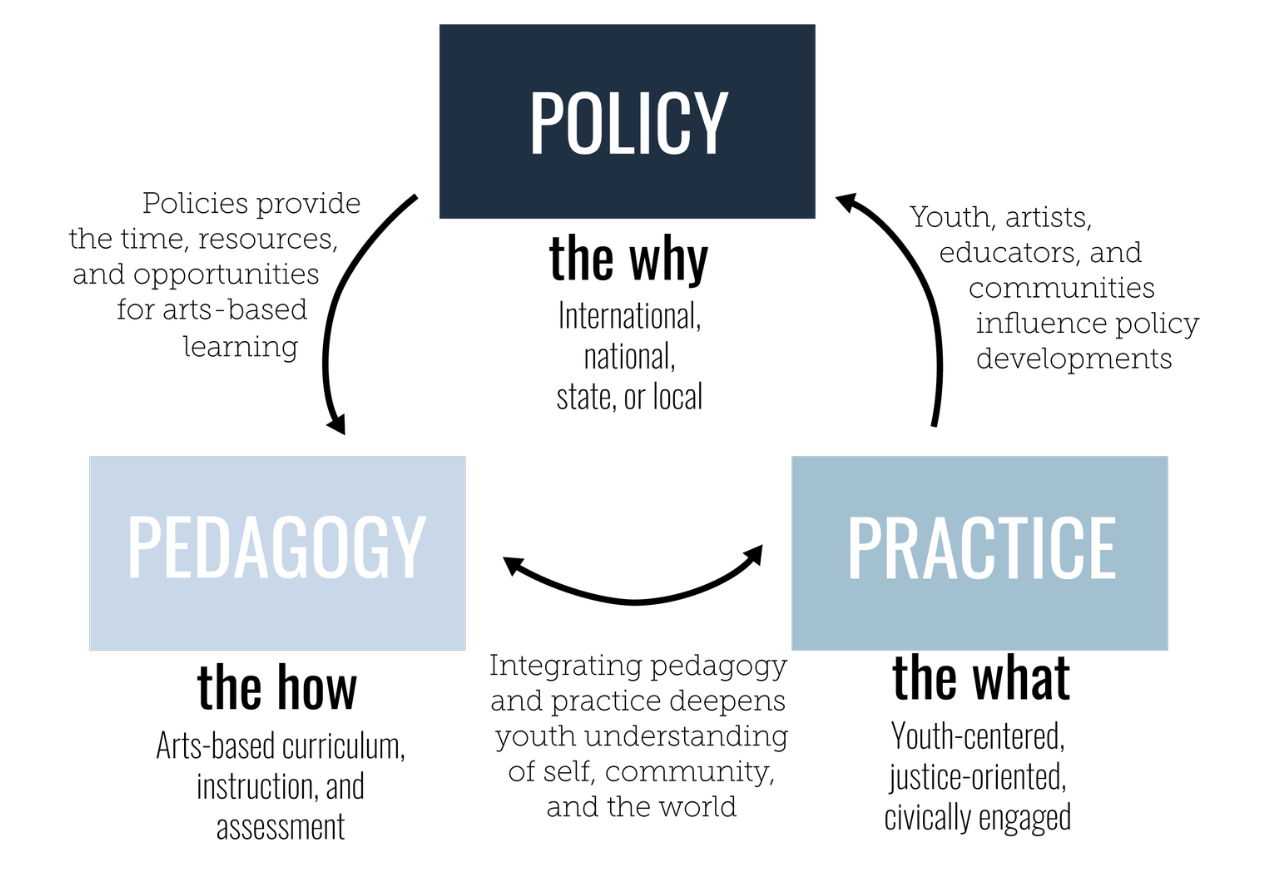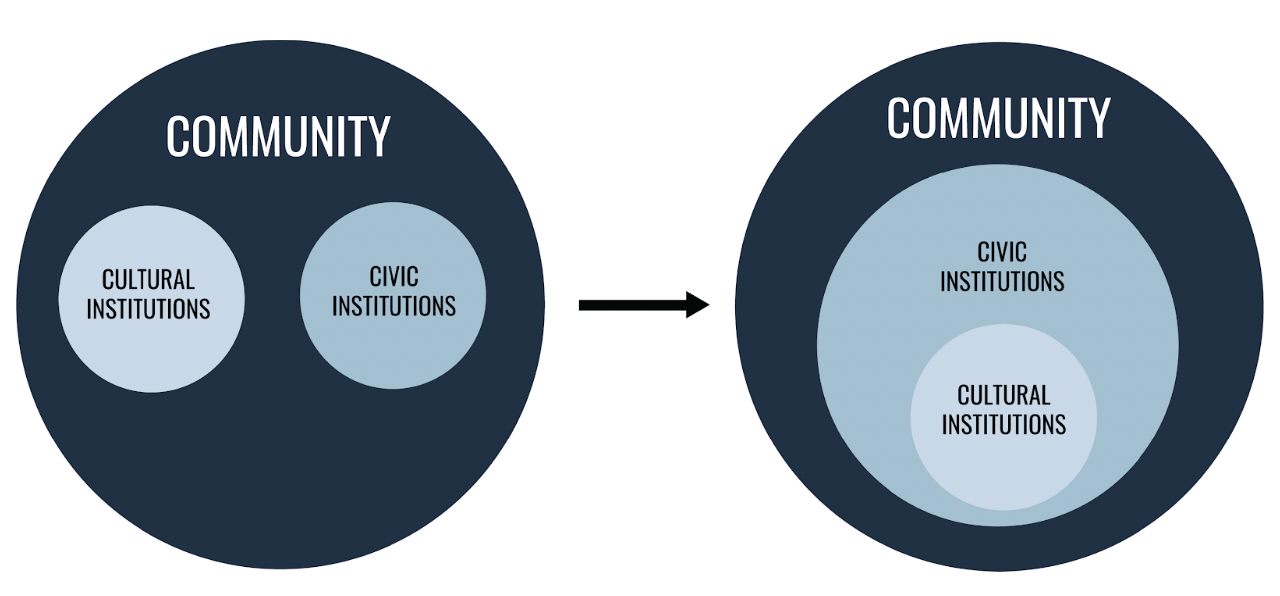By: Jeff Poulin
In our campaign for 2022: Building Creative Features, we have decided to focus quarterly themes on the four inquiry-based processes emerging from our research on leadership in arts and cultural education. This campaign is forward-looking and plural in nature: we are not hoping to creatively build one singular future that will have the most benefit for us as individuals, but rather we are all employing our creativity in order to build a plurality of futures which provide a multitude of pathways for us all.
This quarter’s theme is “bridging”, and the topic where I would like to frame our discussion. (Be sure to check out the series on “unlearning” and “navigating”…and stay tuned for “holding tensions” next! Check out all posts in the 2022 Campaign here.)
Bridging Connections
In our 2020 research on leadership, which uncovered “bridging” as one of the four inquiry-based processes towards a new vision for leadership in arts and cultural education, we learned from over 200 self-identified leaders in the field. When discussing the capabilities, tactics, and modalities which supported their work as leaders, the vast majority were quick to identify the term connection.
As we prodded on the topic – and upon review of the submitted statements, transcripts, and notes, we found three primary themes. According to research participants from around the globe, arts and cultural education leaders were conduits for connection between:
Themselves and others
Their work and others’ work
Their sector and other sectors
This three-pronged approach to bridging was observed to be unified by the specific skill of “bridging.” Bridging, as a leader, fostered the deep and integral connections between individuals, organizations, sectors.
Bridging As Systems Change
Personally, as I have thought about this concept, I think back to some of my initial approaches to Creative Generation’s foundational research, which concluded with three necessary paradigm shifts to best cultivate creativity in the next generation to drive creative social transformation in communities and our world.
As I have been authoring several overview articles about this work (now three years on…wow!), I have been asked to both qualify and visualize the approach I took as a practitioner-researcher. As such, I identified the three lenses, which I organically disclosed at the time of research, but never thoroughly interrogated together. I viewed the traditional and non-traditional literature, original empirical research, and analysis of my findings through four lenses that emerged from my personal and professional lived experiences:
As an individual, specifically a teaching artist;
As a member of networks, specifically networks of practitioners in the cultural and education sectors;
As a staffer and volunteer within organizations, specifically the budding organization that is now Creative Generation (started by a loose network of practitioners, now a formal Collective); and
As a professional working within systems, specifically the education, cultural funding, and public policy systems.
Working with our resident visual artist and Director of Communications & Engagement, Bridget Woodbury, we visualized these four lenses through which I look.
What I find most interesting about my own, personal, critical reflection is that likely due to my academic training in education, arts management, and public policy – is that my default is to bridge the gaps between individual practitioners, their peers, organizations, and systems. Without even knowing it, my own approach is rooted in the concepts we heard from leaders around the world – bridging or being a conduit for connection.
How I applied my own “bridging” was in service of systems change: a topic currently being explored by our own Laurie T. Schell. In this body of work, Laurie discusses the power of the individual and the value of connecting to others to present a set of multiple perspectives towards the change you wish to see in a given system. Stay tuned for more in this series.
Bridging Through Language
Back in our foundational research at Creative Generation, the first of the necessary paradigms shifts identified was that a new vernacular was needed to both unify the field and better articulate the artistic, cultural, and creative processes which cultivate creativity in young people. This was essential to practitioners and programs because the field…
lacks a common language to describe their work and its outcomes, which leads to
severe isolationism among practitioners - such as artists, educators, and community organizations - resulting in insufficient communities of practice, which foments…
a stagnation of pedagogy, due to a dearth of opportunities to exchange knowledge.
So, we proposed a new vernacular, re-conceptualizing the language of our intersectional fields of arts/culture, education, and social change and put forward an enriched vocabulary for the creative generation, creative capabilities, and creative social transformation.
Now, three years later, what I have come to realize is that regardless of the language one uses, it is important for us to bridge by translating so we can connect with peers, form communities of practice, and exchange ideas.
Bridging people enables systems change on a pedagogical-level.
Bridging Policy, Pedagogy, and Practice
The second necessary paradigm shift we discovered was about more deeply integrating public policies, artistic, cultural, and creative pedagogies, and civic, social, and justice-oriented practices.
Last week, I wrote about an enriched understanding of arts integration, which is predicated on the policy, pedagogy, and practice paradigm, which was originally proposed at the 2019 World Summit of the World Alliance for Arts Education in Frankfurt, Germany.
In this model, I propose that the field of arts and cultural education recognizes connections in several realms: a.) there are public policies in place which provide the resources to enable arts-based learning experiences for youth in compulsory, higher, and informal education settings; b.) educators and teaching artists have autonomy to implement those policies and create meaningful learning experiences for youth through the arts and justice-oriented education; and c.) when integrated, those learning experiences can provide new insights and opportunities for leadership and civic engagement by young people to critique (or even influence, change, or dismantle) the policies and systems within which they are living.
When working with case study participants, the impact of this type of bridging is a “flywheel” effect, where the outputs from the implementation of public policies to drive integrations between the pedagogy and practice results in young people, educators, and their communities impacting the development and reform of future policies.
Bridging pedagogy enables systems change on a policy-level.
Bridging in Community
The third necessary paradigm shift we discovered was about the organizational practices and shifting the views of institutions from cultural to civic.
We know that good organizational planning begins and ends with the mission, vision, and values of the organization – especially as crafted by the community constituents of the organization. We have formulated our own process on this, known as Adaptive Impact Planning.
In an organization’s mission, vision, and values, one can easily observe how the institution views itself within community. Inextricably tied to the outward portrayal of every single organization (30 of them!) in our foundational research, was language, which related to the civic role of the organization within the given community.
No longer are arts and cultural education organizations viewing their work as that of artistic or cultural preservation of passive-learning; instead, they view their role as one of creation and active engagement. This was especially seen in the responses to the crises of 2020 by creative youth development programs throughout the United States: arts and cultural education programs behaved like community centers, public health clinics, food pantries, and more.
In this body of research, we (along with our friends at WolfBrown) traced the questions asked by some 41 programs over about 9 months. Overwhelmingly, leaders pondered, made decisions, and learned from the outcomes of their actions; specifically about how they bridged to other sectors to collectively address the seemingly insurmountable challenges they were facing. Some asked, “how can we work with our city health agency to ensure our program participants and families have the latest and best information regarding COVID-19?”, while others connected with the racial justice movements to empower their youth participants to creatively respond to the murders of Black community members by police and vigilantes.
As an arts and cultural education leaders; these folks stood as the conduit of connection between the arts and cultural sector and others, like public health and civic engagement. As such, these other institutions embraced artistic and cultural practices, and the arts organization engaged in public health and civic dialogues. And they continue to do so years after; for many it was integrated into their mission, vision, and values.
Bridging institutions enables systems change on a practice-level.
Conclusions
So, as we ask the big questions and continue to wonder about how we unlearn problematic habits of the past and navigate the complex ecosystem within which we work, let us also bridge the connections between ourselves and others – this is an incredible starting point.
As pointed out by focus group members in that seminal 2020 leadership research, “bridging” is a necessary skill that is fostered through individual, critical reflection and inquiry. Take a moment to ask yourself:
What lenses are you looking through formed by your personal and professional lived experiences? And how do you see yourself as a leader?
How are you translating your language to bridge connections to others doing similar work?
In what ways are you employing policies to integrate arts-based learning more deeply with social, civic, and justice-oriented practices?
How are your organizations viewing themselves as part of the civic and community discourses?
And, lastly, when are you going to get started making systems change?
You’ve made it to the end of this super long blog, so maybe carve out five more minutes of your day to answer these questions now – but then get. to. work!
-
Poulin, J. M. (2022, June 14). BRIDGING: Systems Change to Improve Pedagogy, Policy, and Practice. Creative Generation Blog. Creative Generation. Retrieved from https://www.creative-generation.org/blogs/bridging-to-as-systems-change-to-improve-pedagogy-policy-and-practice



